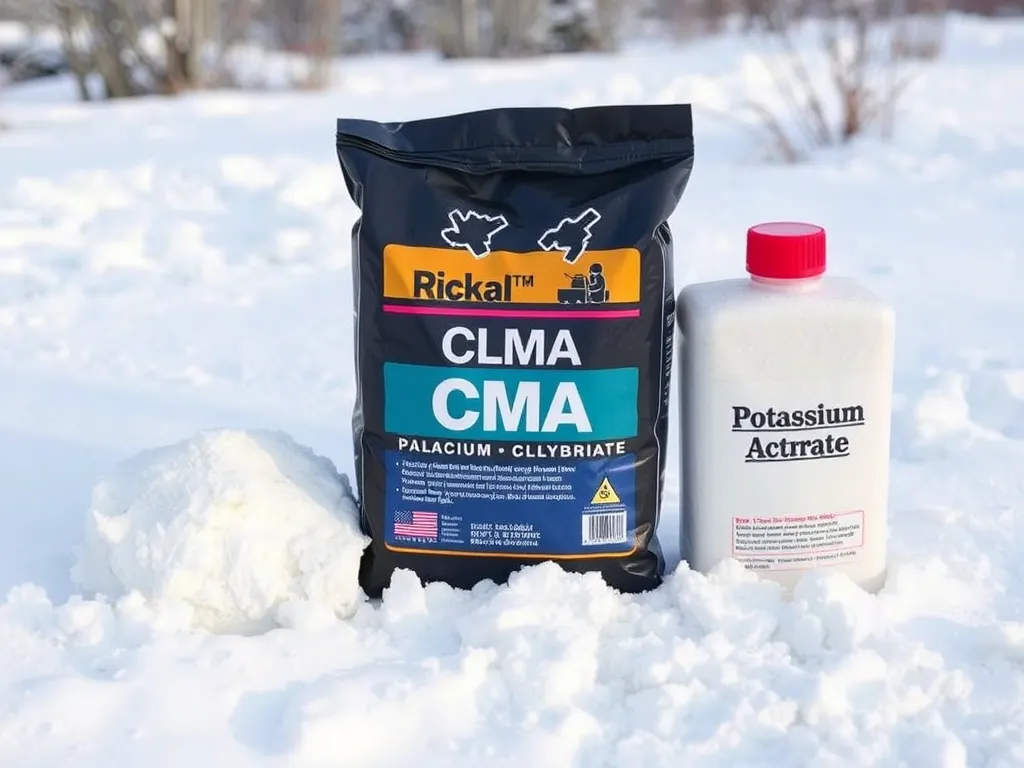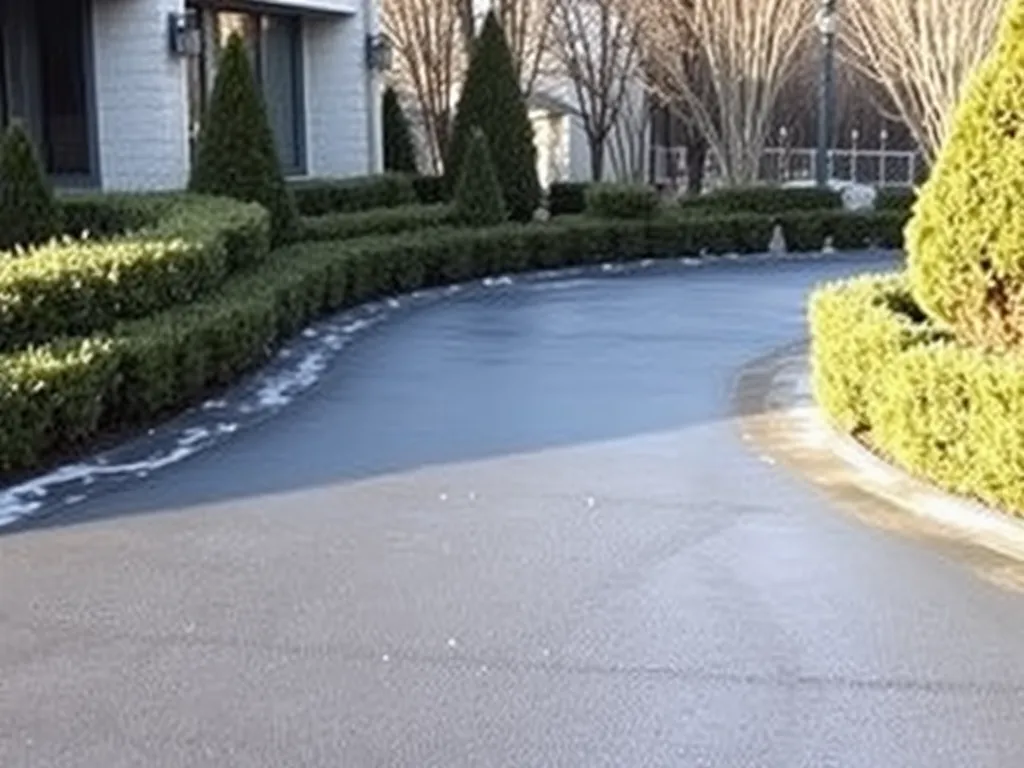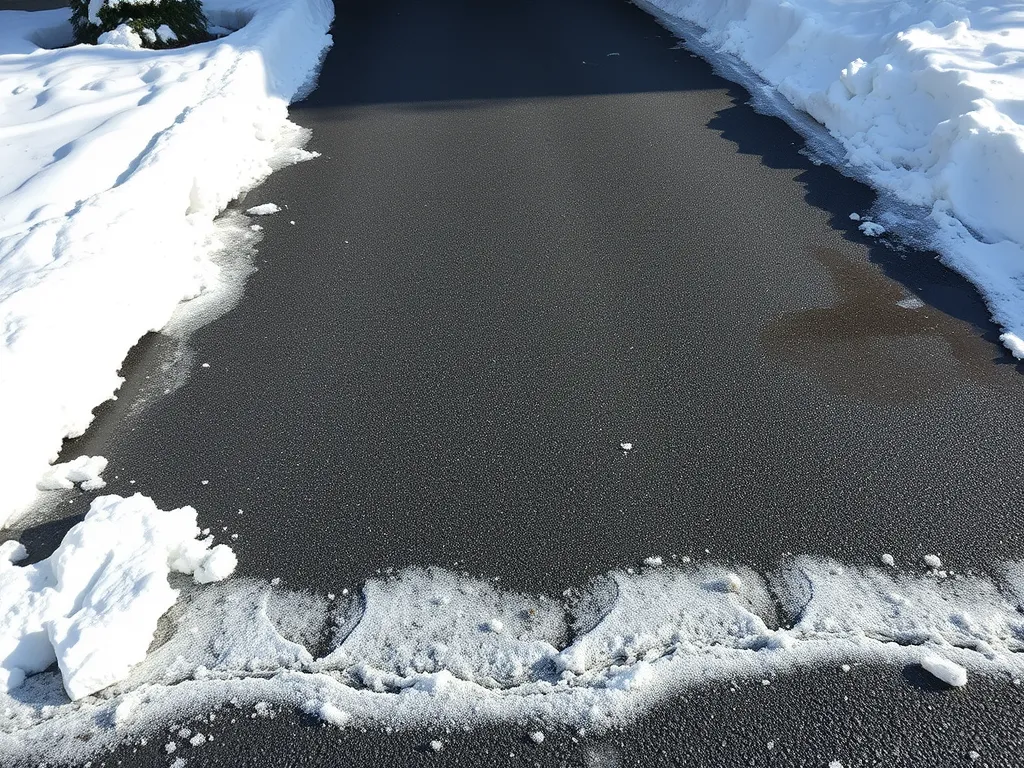Can You Put Salt on an Asphalt Driveway?
Published on: October 7, 2025 | Last Updated: April 14, 2025
Written By: George Voss
Putting salt on an asphalt driveway risks damaging its surface and structure. Rock salt (sodium chloride) chemically reacts with asphalt binder, weakening the pavement over time. This reaction speeds up cracking and erosion during freeze-thaw cycles. While salt melts ice effectively, safer alternatives like calcium chloride or potassium acetate protect your driveway’s durability.
This article explores safe ice melt options, proper application techniques, and winter maintenance practices for asphalt driveways. Discover which products prevent ice without damaging pavement, how to apply them effectively, and strategies to protect against salt-related deterioration. We’ll also cover environmental impacts and answer key questions about preserving your driveway’s integrity.
Contents
Is Salt Safe for Asphalt Driveways?
Using salt on asphalt driveways sparks debate among paving pros. While sodium chloride melts ice fast, its impact on asphalt’s structural integrity demands scrutiny. Blacktop contains bitumen – a sticky petroleum binder holding aggregates together. Harsh chemicals can disrupt this bond.
How Rock Salt Affects Asphalt Surfaces
Rock salt (NaCl) works by lowering water’s freezing point to 15°F. But this de-icing method carries hidden costs for asphalt driveways. Two primary failure modes emerge: chemical breakdown and physical wear.
Chemical Reactions Leading to Asphalt Deterioration
Salt ions penetrate tiny voids in asphalt, reacting with bitumen. This oxidation process dries out binding agents, causing raveling – when aggregate stones loosen from the surface. PG 64-22 binder (common in driveways) loses 18-22% viscosity when exposed to salt brine repeatedly.
Accelerated Cracking and Surface Erosion
Freeze-thaw cycles worsen salt damage. Water expands 9% when freezing inside cracks. Salt amplifies this by drawing more moisture into pavement voids. Truck tires grinding salt crystals into asphalt act like sandpaper, wearing down 1/16″ of surface yearly in northern climates.
Is Rock Salt Safe for Asphalt Driveways?
Contractors agree: rock salt harms asphalt long-term. While occasional use on 2+ year-old driveways may not show instant damage, annual applications cut pavement lifespan by 3-5 years. New asphalt (under 12 months) faces higher risk – salt can inhibit proper curing of AC-20 mixes.
For those needing winter traction, calcium chloride works at -25°F with 45% less chemical aggression. Up next: comparing de-icer options that protect blacktop without compromising slip resistance.
Safe Ice Melt Options for Asphalt Driveways
Not all ice melts work with asphalt. Choosing wrong products risks cracks, pits, or surface wear. Focus on formulas that tackle ice without harming bitumen binders.
Calcium Chloride: Effectiveness and Precautions
Calcium chloride melts ice fast at temps down to -25°F. Draws moisture from air to break ice bonds. Use sparingly—high concentrations can dry out asphalt surfaces. Apply 1.5 lbs per 100 sq ft for light ice. Rinse residue within 48 hours to avoid chemical buildup.
Calcium Magnesium Acetate (CMA) for Low-impact De-icing
CMA combines calcium, magnesium, and acetic acid. Less harsh than chloride-based options. Works down to 20°F. Costs 30% more than rock salt but won’t pit asphalt. Ideal for driveways near lawns—low risk to grass or shrubs.
Potassium Acetate: Environmentally Friendly Alternative
Airports use potassium acetate for its -75°F performance. Biodegradable and non-reactive with asphalt binders. Requires precise application: 2 gallons per 1,000 sq ft. Costs $25-$35 per gallon but prevents freeze-thaw damage long-term.
Key Selection Criteria for Asphalt-Safe Ice Melts
Prioritize products with pH levels between 6-8. Acidic formulas (pH below 5) strip asphalt’s protective oils. Check labels for “asphalt-safe” certification from groups like APAM.
Temperature Range Compatibility
Rock salt fails below 20°F. Match melters to local winters: • Calcium chloride: -25°F • CMA: 20°F • Potassium acetate: -75°F Using a product outside its rating leaves icy patches.
Non-Corrosive and Non-Staining Properties
Avoid chloride-based salts near garage doors or light posts—they rust metal. Test new products on small areas first. Look for “dye-free” labels to skip surface stains from blue or green tinted melts.
Picking smart melters is half the battle. How you apply them matters just as much.

Proper Application Methods for De-icers
Smart snow management on blacktop requires strict protocols. Follow these tactics to limit harm from asphalt driveway salt while maintaining slip-free surfaces.
Pre-treatment Strategies Before Snowfall
Apply liquid brine (23% salt solution) 24-48 hours prior to storms. This proactive method forms a crystal barrier, stopping bond formation between snow and pavement. A 55-gallon tank typically covers 14,000-16,000 square feet. Focus on high-traffic zones: approach lanes and slope transitions. Avoid granular salt during dry conditions – it sits idle until activation.
Controlled Spreading Techniques for Salt Products
Limit rock salt on asphalt driveway surfaces to 1.5 pounds per 100 square feet. Use rotary spreaders with adjustable gates for 8-12 foot patterns. Below 15°F, switch to calcium chloride pellets (works to -25°F) at 0.75 lbs/100 sq ft. Never stockpile mounds – salt concentration spikes trigger binder breakdown. Maintain 6″ clearance from lawn edges to stop turf kill.
| Product | Rate | Temp Range |
|---|---|---|
| Sodium Chloride | 1.5 lb/100ft² | +20°F & up |
| Calcium Chloride | 0.75 lb/100ft² | -25°F to +20°F |
| CMA | 2 lb/100ft² | +15°F & up |
Post-storm Cleanup to Prevent Residue Buildup
Clear slush within 48 hours using poly-blade shovels. Residual salt slurry acts as a brine pool, attacking pavement pores. Power wash with 60°F water if temps stay above freezing. For stubborn salt crusts, apply magnesium chloride rinse (1:4 dilution) followed by stiff broom scrubbing. Annual spring pressure washing removes 85-90% of salt deposits.
Following these application protocols prepares your blacktop for upcoming cold months. What armor exists to shield your pavement from winter’s harsh impacts?
Also See: Can You Ground on Asphalt? Examining Safety and Use
Winter Maintenance for Asphalt Driveways
Smart winter care keeps asphalt safe from salt harm. Three key steps shield your drive: sealcoating, crack fixes, and plant control.
Sealcoating: Critical Protection Against Salt Damage
Sealcoat acts like armor for asphalt. This coal-tar or asphalt-based layer blocks salt from eating into the binder (bitumen) that holds rocks (aggregate) in place. Apply fresh sealcoat every 2-3 years for full shield. Best done when temps stay above 50°F for 24 hours. Tip: Fix cracks wider than 1/4″ before sealing.
Crack Repair and Surface Preparation for Winter
Gaps let salt seep into asphalt’s base layers. Fill hairline cracks with rubberized sealant. For splits over 1/4″, hire pros to inject hot-pour filler. Check slopes and drains before frost hits—water pools freeze faster, needing more salt use. A smooth surface sheds ice easier.
Vegetation Control to Prevent Ice Trapping
Weeds and grass trap snowmelt, creating ice patches. Trim plants within 6″ of drive edges. Kill roots in cracks with glyphosate-free weed killer. Clear leaves fast—they hold dampness. Bare edges let sun and wind dry pavement faster, cutting ice risk.
These steps cut salt harm by up to 60%. Next, weigh eco-impacts of your ice-fight plan.

Environmental Considerations
Salt used on driveways affects more than just your pavement. Let’s break down the eco-impacts and smarter options.
Soil and Water Contamination Risks
Rock salt (sodium chloride) dissolves into sodium and chloride ions. These seep into soil and nearby water sources. Just 1 tsp of salt can pollute 5 gal of fresh water. Over time, this:
- Kills grass and plants near drive edges
- Raises salt levels in groundwater by up to 130%
- Harms fish and bugs in streams
Chloride stays in soil for years, making it hard for new plants to grow. Runoff from asphalt driveways with salt can flow into storm drains, spreading the damage.
Pet-safe and Plant-friendly Alternatives
Swap harsh salts for these safer picks:
- Calcium magnesium acetate (CMA): Works at -10°F, less toxic to paws
- Sand or kitty litter: Adds grip without melt
- Potassium chloride: Melts ice at 25°F but use sparingly
Avoid urea-based melts. They add nitrogen to water, causing algae blooms. For pets, pick CMA or glycine-based products labeled “paw safe.”
Smart de-icer picks protect your pavement and the planet. Now let’s address top questions about winter asphalt care.
FAQs About Using Salt on Asphalt Driveways
Should I Salt My Asphalt Driveway?
While it may seem convenient, salting your asphalt driveway can lead to long-term damage. It’s advisable to explore safer alternatives for ice melting and traction.
When Should You Avoid Salt Application?
Avoid applying salt on new asphalt driveways (less than 12 months old) or during extremely cold temperatures, where the risk of damage increases significantly.
Which Ice Melt Preserves Asphalt Integrity?
Calcium chloride, calcium magnesium acetate (CMA), and potassium acetate are considered safer options for ice melt that won’t harm the integrity of your asphalt driveway.
Can New Asphalt Driveways Tolerate Salt?
No, new asphalt driveways are particularly vulnerable to salt damage. It is best to avoid using salt on driveways that are less than one year old to ensure proper curing and longevity.
Does Salt Cause Permanent Pavement Damage?
Yes, repeated use of salt can lead to permanent damage to asphalt. The chemical reaction with the asphalt binder can weaken the surface and increase cracking over time.

Final Thoughts
Using salt on an asphalt driveway can lead to significant damage over time. The chemical composition of rock salt can cause deterioration, cracking, and erosion of the surface. To maintain the integrity of your driveway, consider safer alternatives like calcium chloride or potassium acetate.
Implementing proper maintenance practices, such as sealcoating and regular crack repairs, is vital for extending your driveway’s lifespan. Be mindful of your choices and apply de-icing products responsibly to ensure both safety and preservation.
For more information on asphalt maintenance and calculator tools, visit Asphalt Calculator USA.


